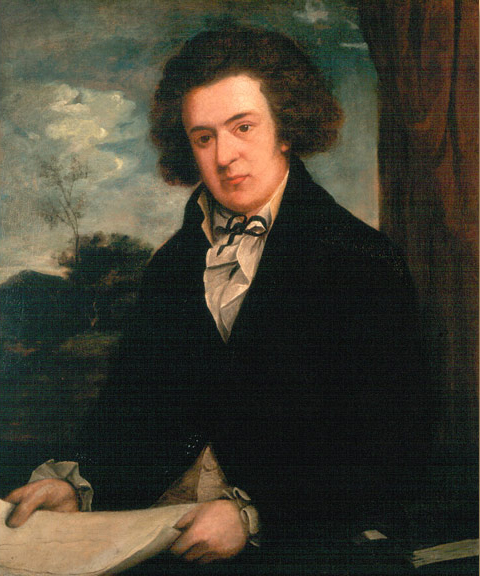President Thomas Jefferson tells Meriwether Lewis of the mentors waiting for him in Philadelphia and informs the public that the expedition is headed to the Mississippi. In Paris, James Monroe, Robert Livingston, and François Barbé-Marbois negotiate a price for Louisiana’s purchase.
Benjamin Smith Barton
by Samuel Jennings[1]Samuel Jennings (d. 1834), a Philadelphian who spent most of his life in London, England, created the first abolitionist painting in America, Liberty Displaying the Arts and Sciences, for the Library … Continue reading
Date and size of original painting unknown. Courtesy American Philosophical Society.
Benjamin Smith Barton (1766–1815) at 37 years of age was the youngest of the five members of the American Philosophical Society to whom Jefferson referred Lewis. Barton expressed an interest, were his health sufficient, in accompanying Lewis at least part of the way. Initial promise but ultimate failure to fulfill exemplified Barton’s role in the history of the expedition and in other projects he contemplated.
Philadelphia Mentors
Washington April 27. 1803.
Dear Sir
. . . . .
I have prepared for you, that you may have time to consider them, & to propose any modifications which may occur to yourself as useful. your destination being known to mr Patterson, Doctrs. Wistar, Rush & Barton, these instructions may be submitted to their perusal. a considerable portion of them being within the field of the Philosophical society, which once undertook the same mission, I think it my duty to consult some of it’s members[2]Thomas Jefferson to Meriwether Lewis, Founders Online, National Archives, founders.archives.gov/documents/Jefferson/01-40-02-0204 accessed 12 May 2022. [Original source: The Papers of Thomas … Continue reading
Public Curiosity
the idea that you are going to explore the Missisipi has been generally given out: it satisfies public curiosity, and masks sufficiently the real destination. I shall be glad to hear from you, as soon after your arrival at Philadelphia as you can form an idea when you will leave, & when be [here.] accept assurances of my constant & sincere affection.
Th: Jefferson[3]Ibid.
Monroe’s Journal
April 27.
Mr. Marbois came to my lodgings by appointment of Mr. Livingston, at two o’clock . . . . Mr. Marbois opened the conversation by presenting us with a project of a treaty given him by the govt. to be proposed to us . . . . That project claimed one hundred millions & the debts due our citizens estimated at 20. more. His own reduced that demand to 80, including the debt.[4]Stanislaus Murray Hamilton, ed. The Writings of James Monroe, Vol IV, 1803–1806 (New York: G. P. Putman’s Sons, 1900), 12; digitized by Google Books and available at archive.org.
Experience the Lewis and Clark Trail
The Lewis and Clark Trail Experience—our sister site at lewisandclark.travel—connects the world to people and places on the Lewis and Clark Trail.
Plan a trip related to April 27, 1803:

Notes
| ↑1 | Samuel Jennings (d. 1834), a Philadelphian who spent most of his life in London, England, created the first abolitionist painting in America, Liberty Displaying the Arts and Sciences, for the Library Company of Philadelphia. |
|---|---|
| ↑2 | Thomas Jefferson to Meriwether Lewis, Founders Online, National Archives, founders.archives.gov/documents/Jefferson/01-40-02-0204 accessed 12 May 2022. [Original source: The Papers of Thomas Jefferson, vol. 40, 4 March–10 July 1803, ed. Barbara B. Oberg. Princeton: Princeton University Press, 2013, pp. 277–278.] |
| ↑3 | Ibid. |
| ↑4 | Stanislaus Murray Hamilton, ed. The Writings of James Monroe, Vol IV, 1803–1806 (New York: G. P. Putman’s Sons, 1900), 12; digitized by Google Books and available at archive.org. |

